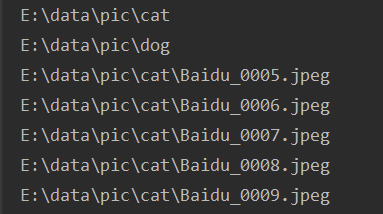1 #coding:utf8 2 import os 3 import sys 4 def listfiles(rootDir, txtfile, label=0): 5 ftxtfile = open(txtfile, 'w') 6 list_dirs = os.walk(rootDir) 7 count = 0 8 dircount = 0 9 for root,dirs,files in list_dirs: 10 for d in dirs: 11 print(os.path.join(root, d)) 12 dircount += 1 13 for f in files: 14 print(os.path.join(root, f)) 15 ftxtfile.write(os.path.join(root, f)+ ' ' + str(label) + '\n') 16 count += 1 17 print(rootDir + ' has ' + str(count) + ' files') 18 19 listfiles('E:/data/pic', 'E:/data/txtfile.txt')
python 文件操作之open,read,write
1、open
#open(filepath , 'mode')
file = open(‘E:/data/testfile.txt’,‘w’)
一般常用模式:r(只读)、w(只写)、a(追加)、b(二进制)
组合:r+(读写)、w+(读写)
2、读文件(r): read() readline() readlines()
file = open('D/test/test.txt','r') #只读模式打开file
3、write(w)
1 file = open('E:/data/txtfile.txt','w+') #只写模式打开file 2 file.write('11111')

python的os.walk()函数的使用及对于root,dirs,files的理解
root指的是当前所在的文件夹路径,dirs是当前文件夹路径下的文件夹列表,files是当前文件夹路径下的文件列表。
所以我们可以通过root和dirs的某项组合出文件夹路径,通过root和files的某项组合出文件路径。
1 import os 2 path = r'E:\data\pic' 3 for root, dirs, files in os.walk(path): 4 #print(root, dirs, files) 5 for name in files: 6 print(os.path.join(root,name)) 7 for name in dirs: 8 print(os.path.join(root,name))
